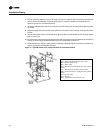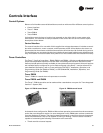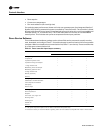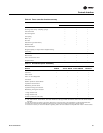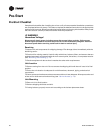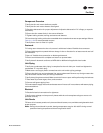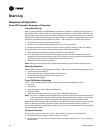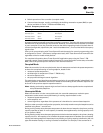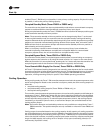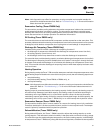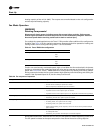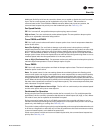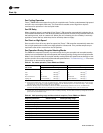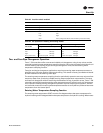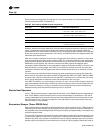
50 BCXC-SVX01B-EN
Start-Up
enabled (Tracer™ ZN520 only) and possible, it is the primary cooling capacity. If hydronic heating
is possible, it will be the primary heating capacity.
Occupied Standby Mode (Tracer ZN510 or ZN520 only)
The controller can be placed into the occupied standby mode when a communicated occupancy
request is combined with the local (hardwired) occupancy binary input signal.
During occupied standby mode, the Tracer™ ZN520 controller’s economizer damper position goes
to the economizer standby minimum position.
Note: The economizer standby minimum position can be changed using Rover™ service tool.
In the occupied standby mode, the controller uses the occupied standby cooling and heating
setpoints. Because the occupied standby setpoints typically cover a wider range than the occupied
setpoints, the controller reduces heating/cooling demand for the space. Also, units with Tracer™
ZN520 and the fresh air economizer damper use the economizer standby minimum position to
reduce heating and cooling demand.
When no occupancy request is communicated, the occupancy binary input switches the
controller’s operating mode between occupied and unoccupied. When no communicated
occupancy request exists, the unit cannot switch to occupied standby mode.
Occupied Bypass Mode, Tracer ZN510 or ZN520 Only
The controller can be placed in occupied bypass mode by either communicating an occupancy
bypass request to the controller or by using the timed override “on” button on the zone sensor.
When the controller is in unoccupied mode, pressing the “on” button will place the controller into
occupied bypass mode for the duration of the bypass time (typically 120 minutes).
Tracer Summit With Supply Fan Control, Tracer ZN510 or ZN520 Only
All Tracer™ ZN lockouts (latching diagnostics) are manually reset whenever the fan mode switch
is set to the off position or when power is restored to the unit. The last diagnostic to occur is retained
until the unit power is disconnected. Refer to Trane publication CNT-SVX04A-EN, Installation,
Operation, and Programming Guide, for specific Tracer ZN520 operating procedures.
Cooling Operation
During cooling mode, the Tracer™ ZN controller attempts to maintain the space temperature at the
active cooling setpoint. Based on the controller’s occupancy mode, the active cooling setpoint is
either the:
• occupied cooling setpoint,
• occupied standby cooling setpoint (Tracer ZN510 or ZN520 only), or
• unoccupied cooling setpoint.
The controller uses the measured space temperature, the active cooling setpoint, and discharge air
temperature (Tracer™ ZN520 only) along with the control algorithm to determine the requested
cooling capacity of the unit (0–100%). The outputs are controlled based on the unit configuration
and the required cooling capacity. To maintain space temperature control, the cooling outputs
(modulating or 2-position hydronic valve, or economizer damper) are controlled based on the
cooling capacity output.
Note: Economizer dampers and modulating valves are only available on units with the Tracer™
ZN520 controller. Two-position dampers are only available on units with Tracer ZN010 and
ZN510.
Cooling output is controlled based on the cooling capacity. At 0% capacity, all cooling capacities
are off and the damper is at minimum position. Between 0 and 100% capacity, the cooling outputs
are controlled according to modulating valve logic (Tracer™ ZN520 only) or cycled with 2-position
valves. As the load increases, modulating outputs open further and binary outputs are energized
longer. At 100% capacity, the cooling valve or damper is fully open (modulating valves) or on
continuously (2-position valves).



